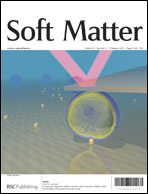Core–shell microgels as “smart” carriers for enzymes†
Abstract
We present a thermodynamic study of the adsorption of lysozyme on a negatively charged core–shell microgel at pH 7.2. The carrier particles consist of a polystyrene core onto which a charged poly(N-isopropylacrylamide-co-acrylic acid) network is attached.


 Please wait while we load your content...
Please wait while we load your content...